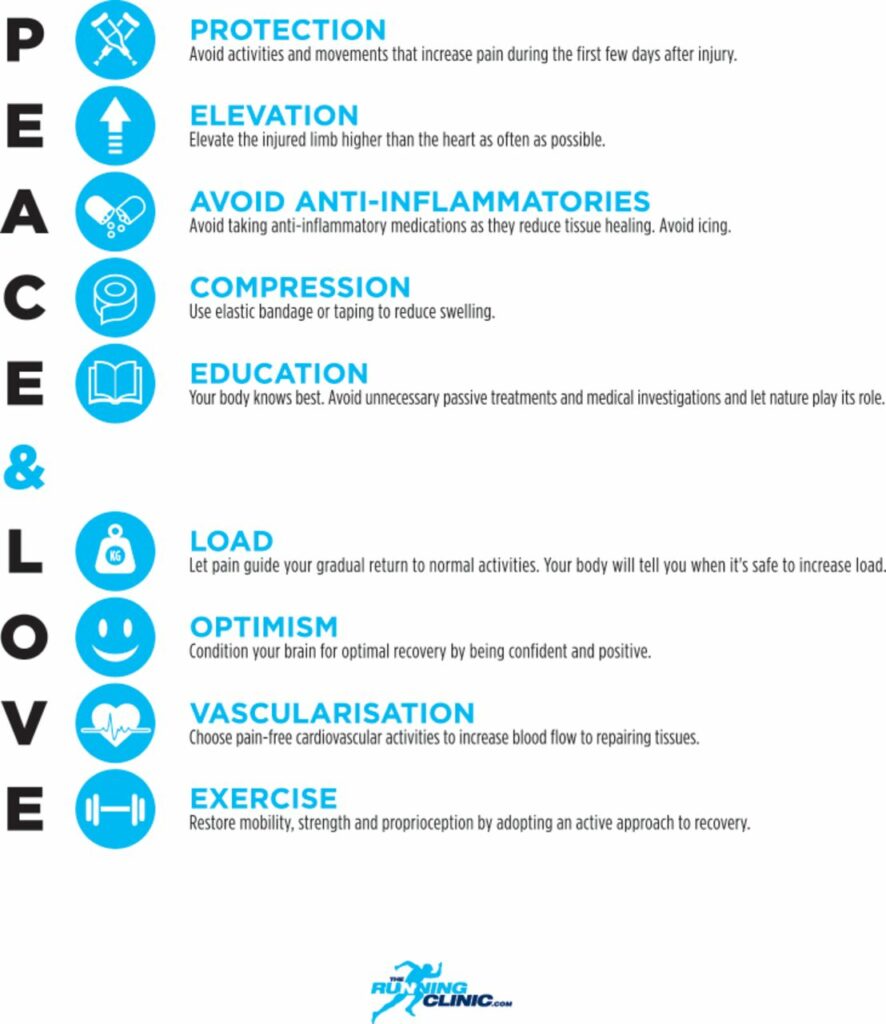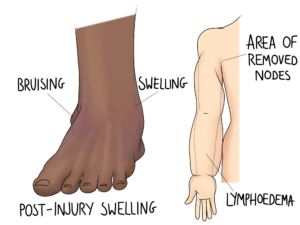Osteopaths don’t just treat problems with bones- all of the body’s systems are connected, and some issues of circulation fall within our remit too.
The circulatory system looks after the musculoskeletal system: the system that you might associate more with osteopathy. Circulation is not just about blood in arteries and veins, but also about lymphatics. The close relationship is particularly obvious with injuries and conditions that cause swelling or bruising.
Post-Injury Swelling
After an injury like a sprain, you might experience some dramatic swelling. Although we might want to reduce the level of swelling, we don’t want to remove it completely. Why? Because the swelling is there to serve a purpose.
Circulation in the Lymphatic System
The fluid involved in this kind of swelling is not blood, but lymph. When blood enters a cell, some components remain in the cell after the rest of the blood has left to return to a vein. This leftover fluid is a colourless liquid called lymph. It flows back into circulation through the lymphatic system, which is a much slower-moving system than blood, as it is driven by positive and negative pressure instead of a pump (the heart). The fluid squeezes through the tiny gaps between cells until it finds a lymphatic vessel. It then flows through the vessels until it reaches a larger duct, which will bring it back into the venous system.
The lymphatic system plays a major role in immunity. As the lymph flows through vessels, it will come across lymphatic glands. You may be more familiar with them as simply “glands”: the points around your neck that go lumpy when you have a cold or a sore throat. They enlarge as they fight infection, and they are present all over the body. If you used to graze your knees a lot as a child, you might find that the glands behind your knees are permanently lumpy, as they’ve fought so many infections in the past.
Lymph contains a number of immune cells, such as white blood cells. Their role is to envelope and digest dead tissue, including foreign bacteria and other pathogens that the immune system has already killed.
Swelling for Healing
 With all of this in mind, it makes sense that you might not want to clear an injured area of lymphatic swelling. Using the sprained ankle as an example, what happens when swelling develops?
With all of this in mind, it makes sense that you might not want to clear an injured area of lymphatic swelling. Using the sprained ankle as an example, what happens when swelling develops?
- Injured ligaments need to be repaired
- Lymph arrives bringing cells that can clean up the injury, and nutrients to facilitate healing
- Pressure of swelling also encourages fluid to leave quicker, removing waste products more effectively.
Issues only tend to arise if the swelling is excessive, causing further stretching of tissues in the area and discomfort. So overall, lymph based swelling after an injury is a good thing. For this reason, you don’t want to spend too long resting, icing, compressing, and elevating the area. In fact, the RICE guidance is under question, with PEACE and LOVE suggested as an alternative.
This advice focuses on taking the edge off the swelling while still allowing it to do its job. It also offers some basic guidance for management after the early stages to encourage a better recovery. Understanding when to return to load bearing and exercise is key for strengthening the tissues again at the optimum point.
Lymphoedema
Lymphoedema literally means “lymph-swelling”, and it refers to a build-up of lymphatic fluid. This commonly affects the arms or legs, and may be a side effect of surgery such as treatments for cancer. It can also be the result of a genetic abnormality that results in unusual development of the lymphatic system. These differences can affect structure, and function.
Lymphoedema Following Lymphectomy
Lymphectomy is a surgical removal of lymphatic vessels and glands. This is not unusual in oncology, where removing the tissue helps to limit the spread of cancer through the rest of the body. However, with vessels lost or compromised, lymph cannot flow as readily as it did before, and it will build up on the distal side of the surgery (typically a limb). Some forms of breast cancer spread to the lymph nodes in the armpit, so removal of these nodes is an important part of treatment. This may lead to lymphoedema in the arm, which can be supported with exercises, compression bandages, and lymphatic massage.
Lymphatic Massage
A practitioner who understands the way lymph moves can give some temporary relief and reduce the build-up of fluid with massage techniques. This is a therapy we offer at the Good Health Centre, provided by Kirtida. As long as the lymphatics are compromised, swelling will return, but encouraging its flushing through can help with the local tissue health and relieve associated discomfort for some time. There are techniques you can continue to perform at home between appointments too. Your practitioner can show you how to do these, and give you advice on how often you should do them. In a similar vein, we have Perrin Technique practitioners who work with the lymphatic system to help with the symptoms of ME and long covid.
Click here to make an appointment in Leeds for your circulation
